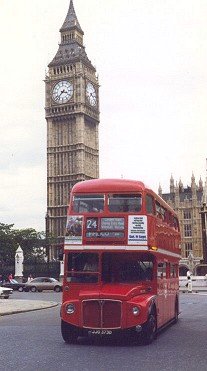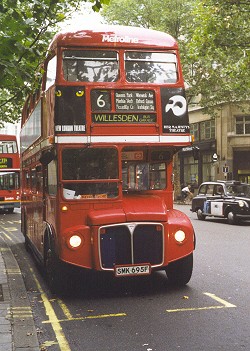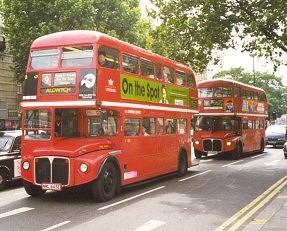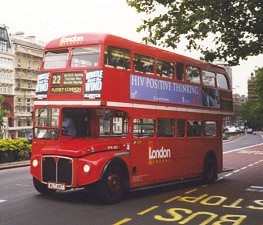
Prepared on Notepad by Ian Smith,
|
| Date | Route | Garage | Type displaced | Displaced by.. |
|---|---|---|---|---|
| 1/81 | 48: London Bridge Stn - Whipps Cross | T | RML | RM |
| 1/81 | 38: Victoria Stn - Leyton Green | T | RM | RML |
| 4/81 | 6/6A: Hackney Wick - Oxford Circus / Kensal Rise Stn | H - AG | RML(H) | RML(AG) |
| 4/81 | 243: Wood Green Stn - Holborn Circus | SF - AR | RML(SF) | RML(AR) |
| 4/81 | 37: Peckham - Hounslow | SW - N | RML(SW) | RML(N) |
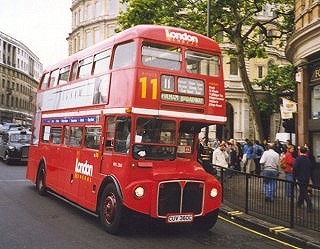
During the retractions forced on LT by the Fares Fair's Unfair ruling there
were further shifts towards the centre of remaining RMs, and service reductions,
resulting in RMLs appearing on route 11, operated by Ash Grove,
and the completion of the part-allocations on the 38 (T) and 207 (HL).
RML2360 on route 11 in June 1998, in Trafalgar Square.
The route is now operated by London General, from their Waterloo garage.
The RMLs were prominently route-branded from 1985 onwards as part of a tourist initiative,
and have retained the branding, unlike some other routes.
On the debit side, the 104 (HT), earliest RML route, was converted to opo.
| Date | Route | Garage | Type displaced | Displaced by.. |
|---|---|---|---|---|
| 9/82 | 11: Liverpool St Stn - Shepherds Bush Green | AG | RM | RML |
| 9/82 | 104: Barnet Church - Moorgate | HT | RML | M |
1983-84: Much change, little change.
Although these two years saw the end of London Transport as a London-controlled authority and its replacement by the nationalised London Regional Transport, with its subsidiary operating company London Buses Ltd, there was little impact on the RML fleet other than a change of legal lettering. As the opo revolution carved swathes through the RM fleet the RMLs stayed busily at work doing what they were good at: moving crowds through the cities of London and Westminster.1985: Route branding.
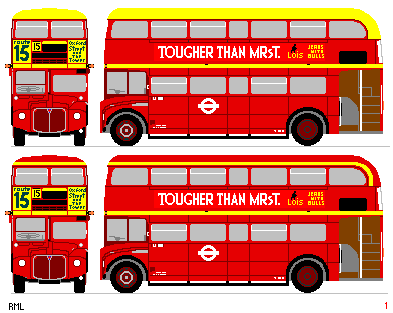 A tourism initiative in May 1985 saw Upton Park's routes 15 and 23 renumbered as 15A and 15 respectively,
with tourist leaflets and prominent yellow marking of the buses allocated.
At first a complete yellow roof was applied,
but this was quickly changed to a subtler yellow roof band.
The cantrail band was also yellow, and route posters replaced the front advertisements.
Special front blinds were also used.
A tourism initiative in May 1985 saw Upton Park's routes 15 and 23 renumbered as 15A and 15 respectively,
with tourist leaflets and prominent yellow marking of the buses allocated.
At first a complete yellow roof was applied,
but this was quickly changed to a subtler yellow roof band.
The cantrail band was also yellow, and route posters replaced the front advertisements.
Special front blinds were also used.
Other routes were incorporated into the tourist network later in the year, but some garages failed to ensure that branded buses stayed on route and the scheme had a limited life on most routes. Some, however, have retained it, with variations, to the present.
Major re-locations
The period of relative stability for the RMLs ended suddenly in August 1985. The 243 (Tottenham), 48 (Leyton) and 74 (Putney) were both converted to opo, as was the 77A (worked by a mixed bag of RMs, RMLs, Ds and a V by Stockwell). The 77 received the 77A collection, while the other RMLs moved to Muswell Hill and Finchley for the 43.| Date | Route | Garage | Type displaced | Displaced by.. |
|---|---|---|---|---|
| 8/85 | 243: Wood Green Stn - Holborn Circus | AR | RML | M? |
| 8/85 | 48: London Bridge Stn - Whipps Cross | T | RML | T? |
| 8/85 | 74: Camden Town - Putney Heath | AF | RML | M? |
| 8/85 | 77A: Kings Cross Stn - Raynes Park | SW | RML, RM, D, V | M? |
| 8/85 | 43: Friern Barnet - London Bridge Stn | MH, FY | DM | RML |
| 8/85 | 77: Euston Stn - Tooting | SW | RM, RML, D, V |
1986: Tendering shuffles
The tendering process was causing frequent shifts in bus allocations now that it was in full swing, and the process applied the screws viciously to crew worked services except where they were part of the specification. Garages were closing, morale was very low, RMs were heading for sale or scrap by the hundred. The RMLs were surviving by dint of their superior capacity (and hence productivity on heavily-used routes). Even central routes were falling to opo now. The 8A was converted to Titan operation in June 1986, losing some RMLs from Bow. New Cross lost its minority RML stake in route 37 at the same time. The RMLs shifted back to Stamford Hill to work with RMs on the 253.Later in the summer the 24 began to receive Metrobuses and Titans, ready for a changeover in October. The displaced RMLs went back to Tottenham for the 73.
| Date | Route | Garage | Type displaced | Displaced by.. |
|---|---|---|---|---|
| 6/86 | 8A: Old Ford - London Bridge Stn | BW | RML | T |
| 6/86 | 37: Peckham - Hounslow | NX | RML | re-allocated |
| 8/85 | 253: Aldgate - Warren Street | SF | RM | RML, RM |
| 8/85 | 24: Pimlico - Hampstead Heath | CF | RML | M, T |
| 8/85 | 73: Tottenham - Hammersmith Broadway | AR | ? | RML |
1987: A day of rest, weeks of stress
Crew working on Sundays was a major target during 1987, with RMLs (and RMs) displaced by opo types on Sunday duties wherever possible.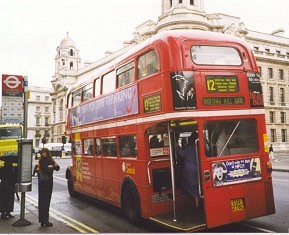
When Streatham garage re-opened in February, and moved back from Clapham,
it passed its 137 allocation of RMLs to Brixton (BN).
At the same time route 14 was split,
leaving Putney with the western end, and RMLs,
while Holloway's end was converted to opo as the 14A.
Holloway managed to hold on to some of its RMLs
which appeared on the 29 and 19.
The 207 was changed over to Metrobuses in March, Uxbridge and Hanwell
losing their RMLs to Norwood (N) for the 2B and to Camberwell (Q) and Peckham (PM) for the 12,
thereby starting another relationship which would last.
RML 2279 in Whitehall on route 12 in June 1998.
Titans ousted RMLs from route 55 Leyton (T) in June 1987. They too went to Norwood for the 2B.Muswell Hill (MH) also lost its RMLs (again) in favour of Metrobuses on the 43.
Ash Grove's RMLs on the 11 were redistributed to the route's other garages in August, when the closure of Clapton (CT) caused changes in workloads.
October saw further conversions to opo: Cricklewood's 16 group progressively changed to Metrobuses, as did the 253, worked by Stamford Hill and Ash Grove. The RMLs went to Putney for the 22; stayed at Stamford Hill for the 9; went to Westbourne Park (X) for the 7; initiated the 135 at Holloway.
Two more surviving routes that were given RMLs in 1987:
route 9, operated now by London United, sports RMLs 2645 and 2298 on a sunny day in June 1998
(Kensington);
on the same day route 22, worked by London General, utilises RML 887 (Hyde Park Corner).
| Date | Route | Garage | Type displaced | Displaced by.. |
|---|---|---|---|---|
| 2/87 | 137: Crystal Palace - Oxford Circus | AK - BN | RML (AK) | RML (BN) |
| 2/87 | 14A: Hornsey Rise - Tottenham Court Road | HT | RML | T |
| 3/87 | 207: Uxbridge Stn - Shepherds Bush Green | UX, HL | RML | M |
| 3,6/87 | 2B: Golders Green - Crystal Palace | N | RM | RML |
| 3/87 | 12: Dulwich - Notting Hill Gate | Q, PM | RM | RML |
| 6/87 | 55: Leyton - Bloomsbury | T | RML | T |
| 6/87 | 43: Friern Barnet - London Bridge Stn | MH | RML | M |
| 10/87 | 16/A: Victoria Stn - Sudbury Town | W | RML | M |
| 10/87 | 253: Aldgate - Warren Street | SF, AG | RM, RML | M |
| 10/87 | 22: Putney Common - Piccadilly Circus | AF | RM | RML |
| 10/87 | 9: Hammersmith - Aldwych | SF | RM | RML |
| 10/87 | 7: Acton - Oxford Circus | X | RM | RML |
| 10/87 | 135: Archway - Marble Arch | HT | new route | RML |
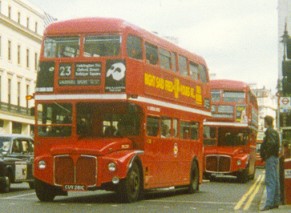 Also in 1987 the London Buses logo appeared: a red bullseye with a white outline and yellow crossbar,
with London Buses written across the bar.
Also in 1987 the London Buses logo appeared: a red bullseye with a white outline and yellow crossbar,
with London Buses written across the bar.
In the last part of the year a start was made on refurbishing the RMLs,
which were becoming decidedly tatty.
A repainting programme improved the appearance of the fleet quite dramatically.
Structural examinations revealed that the basic structure was still sound,
and thought turned to the question of engines and lighting,
with experiments in both areas.
RML2281 works the new route 23 at Charing Cross in August
1992, wearing the London Buses logo. (Photo by Peter Smith)
1988: Grey-Green wins the 24.
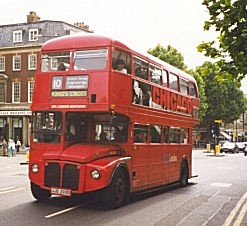
Although the 24 had ceased to be RML worked two years before, its long association with them from the days of the Atlantean trials caused ripples of dismay when the route was allocated to Grey-Green instead of London Buses on the 1988 tender round. This brought a radically different livery to Whitehall and Parliament Square, a politically significant symbol of the Government's privatisation policy. (The observation that Grey-Green did a good job on the route with their grey and green Volvos seemed to be neither here nor there in the political and emotional arguments).
A significant route introduction in August was the 10,
formed from the western arm of the now-truncated 73,
and operated by a mix of RMs and RMLs.
MTL's RML2395 on the 10 at Hyde Park Corner (June 1998).
The crude hole in the front is for a bus-lane camera.
| Date | Route | Garage | Type displaced | Displaced by.. |
|---|---|---|---|---|
| 8/88 | 10: Kings Cross - Shepherds Bush | new route | RML, RM |
Within London Buses the new operating units took control during 1988, showing the direction that London Buses was taking towards privatisation. Perhaps it was the uproar around the rest of the country, as de-regulation produced a rash of new services but fewer riders and more car congestion, that slowed the approach to the actual sell-off of the London units.
1989: Minibuses join the fray.
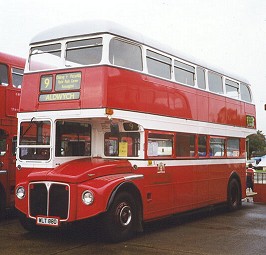
The operational theory of central routes was given a further twist in March 1989 when a fleet of Mercedes minibuses took over a central route from Routemasters: the 28. The idea was to use a large fleet to provide a high frequency service, thus maintaining capacity, reducing waiting times and thereby increasing the attractiveness to customers. That was the theory.
Conductors at Westbourne Park found work by a reallocation to the garage of part of the RML fleet on the 15.
In April the new operating units became semi-independent. As an assertion of independence perhaps, London United painted the doyenne of the class into London United Tramways livery, and relabelled it as ER880, its original number.
ER880 remained in the special livery, as London United's showbus. It is seen here in 1998 at Showbus. It sports the DMS style turn-indicators on the cantrail that were introduced in the early 90's refurbishments.
Part four: Towards the millenium
 Part Two: Survival
Part Two: Survival
 Part Four: Millenium
Part Four: Millenium
 photos
photos
 histories
histories
![]()
 Ian's Bus Stop
Ian's Bus Stop
 RM Contents
RM Contents
 RCLs
RCLs
 RMLs
RMLs
 RMFs
RMFs
